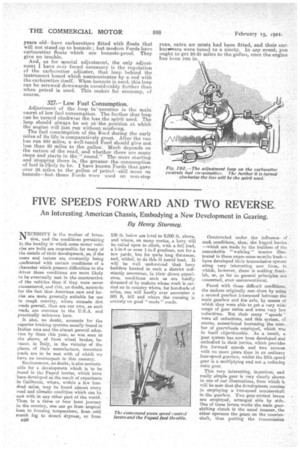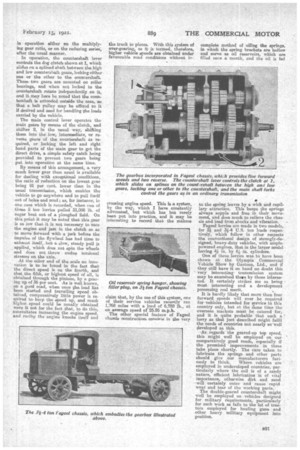FIVE SPEEDS FORWARD AND TWO REVERSE.
Page 24

Page 25

If you've noticed an error in this article please click here to report it so we can fix it.
An Interesting, American Chassis, Embodying a New Development in Gearing. By Henry Sturnley.
MECESSITY is the mother of inven
tion, and the conditions pertaining. in the locality in which 801110 motor vehicles are built are responsible for many of the details of their development, as, if the users and testers are constantly being confronted with certain conditions of a character which present difficulties to the driver those conditions are more likely , to be eventually met in the construction of the vehicles than if they were never encountered, and this, no doubt, accounts. for the fact that American cars and lorries are more generally suitable for use in rough country, where unmade dirt roads prevail, than are our own, as such roads are common in the U.S.A. and practieelly unknown here.
It also, no doubt, accounts for the superior braking systems usually found in Italian cars and the almost general adop. lion by them this year, as was seen at the shows, of front wheel brakes, because, in Italy, in the vicinity of the places of their manufacture, mountain roads are to be met with of which we have no counterpart in this country.
Environment, no doubt, is also accountable for a development which is to be found in the Fageot lorries, which have been developed as the result of experience in California, where, within a few hundred miles, may be found almost every road and clima,tic condition which can be met with in any other part of the world. Thus, in a three or four hour journey in the country, one can go from tropical beat to freezing temperature, from cold marsh fog to desert dryness, or from 1320 100 fk below sea level to 8,000 ft. above, and where, on many routes, a lorry Will be called upon to climb, with a full load, a 1-in-4 or even 1-in-3 gradient, not for a few yards, but for quite long distances, and, withal, to do this in torrid heat. It will be well understood that) lorry builders located in such a district constantly encounter, in their direct experience, conditions such as are hardly dreamed of by makers whose. work is carried on in country where, for hundreds of miles, one will hardly over encounter a 500 ft. hill and where the running is entirely on good " made" roads.
Constructed under the influence, of such conditions, then, the hagcol. lorries --which are made by the builders of the remarkable " walking " tractor illustrated in these pages seine months back— have developed their transmission system along very interesting new lines, in which, however, there is nothing freakish, or, so far as general principles are concerned, even tmconventionaL Paced with these, difficult conditions, the makers originally met, them by using a second gearbox interposed between the main gearbox and the axle, by means of which they were able to get a very wide range of gear ratios and some very low reductions. But their many "speeds" were all reductions, and this system, of course, necessitated increasing the num. her of gearwheels employed, which was in itself objectionable. As a result, a gear, system has now been developed and embodied in their lorries, which provides five forward speeds and two reverse with no more gears than in an ordinary four-speed gearbox, whilst the fifth speed gear is a multiplying and not a reducing ratio gear.
This very interesting, ingenious, and really simple gear is very clearly shown in one of our illustrations, from which it will be seen that the development consists' in employing a two-speed countershaft in the gearbox. Two gear-control levers are employed, arranged side by side. One of these levers works the main gearshifting clutch in the usual manner, the other operates the gears on the counter. shaft, thus putting the transmission
in operation either en the multiplying gear ratio, or on the redwing series, after the usual manner.
In operation, the countershaft lever controls the dog clutch shown at 1, which slides en a spliced shaft between the high and low countershaft gears, locking either one or the other to the countershaft. These two gears are mounted on roller bearings, and when net, locked to the countershaft rotate independently on it, and it-may here be noted that the come tershaft is extended outside the case, so that a belt pulley may be affixed to it if desired and used for handling tihe loads carried by the vehicle.
The main control lever operates the main gears by means of the clutch, and shifter 2, in the usual way, ehifting them into the low, intermediate, or reverse gears of the countershafts as required, or locking the left and right hand parts of the main gear to get the direct drive, a simple safety catch being provided to prevent two gears being put into operation at the same time.
By means of this arrangement, a very much lower gear than usual is available for dealing with exceptional conditions, the ratio of reduction on the lowest gear being 91 per cent, lower than in the usual transmission, which enables the vehicle to go anywhere and to pull itself out of holes/ and mud; as, for instance, in one case which is recorded, when one of these 5 ton lorries pulled 31,000 lb. of sugar beet out of a ploughed field. On this point it may be noted that this gear is so low that it is not necessary to race the engine and jam in the clutch so as to move forward with a jerk before the impulse of the flywheel has had time to exhaust itself, ,but a slow, steady pull is applied, which does not spin the wheels and does not throw undue torsional stresses on the axle.
At tlie other end of the scale an innovation is to be found in the fact that the direct speed is on the fourth, and that the fifth, or highest speed of all, is obtained through the pinions, by a gearing up of 36 per cent. As is well known, on a good mad, when once the load "has been started and travelling speed obtained, comparatively little power is required to keep the speed up, and much higher speed could be usually obtained were it not, for the fact that to do this, necessitates increasing the engine speed, and racing the engine knocks itself and the truck to pieces. With this system of over-gearing, as it is termed, therefore, higher vehicle speeds are obtained under favourable road conditions without ie creasing engine speed. This is a system, by the way, which I have constantly advocated, but which has but rarely been put into practice, and it may be interesting to record that. the makers claim that, by the use of this system, one of their service vehicles recently ran 1,768 miles with a lead of 6,750 lb., at an average speed of 25.95 m.p.h. The other special feature of Fageol chassis oonstructions coneiste in the very complete method of oiling the springs, in which the spring brackets are hollow and serve as oil reservoirs, which are filled once a month, and the oil is fed
to the spring leaves by a wick and capillary attraction. This keeps the springs always supple and free in their movement, and does much to relieve the elmssie and load from shocks and vibration.
Fageol lorries are made in two models,
for 2 and 4-4 U.S. ton loads respectively, which follow in other respects the conventional design of strongly-designed, heavy-duty vehicles, with amplepowered engines, that in the larger model having 44 in. by 64 in. cylinders.
One of these lorries was to have been shown at the Olympia Commercial Vehicle Show by Gastons, Ltd., and if they still have it on hand no doubt this very interesting transmission system may be examined the by those interested. It certainly strikes me as being most interesting and a development possessing real merit.
It is hardly likely that more than four forward speeds will ever be required for vehicles intended for service in this country only, but at the aline time the overseas markets meat be catered for, and it is quite probable that such a lorry as that just described might fulfil the needs of countries not nearly so well developed as this.
As _regards the geared-up top speed, this might well be employed on our comparatively good roads, especially if the promised improvements in these take place shortly. The care taken to lubricate the springs and other parts should give our manufacturers furi
ously to think. Where vehicles are employed in undeveloped countries, par. ticularly where the soil is of a sandy nature, efficient lubrication is of vital importance, otherwise dirt and sand will certainly enter and cause rapid wear and tear of the working parts.
The double-geared countershaft might well be employed on vehicles designed for military requirements, particularly for such work as falls to the lot of tractors employed for hauling guns and other heavy military equipment into position.
































